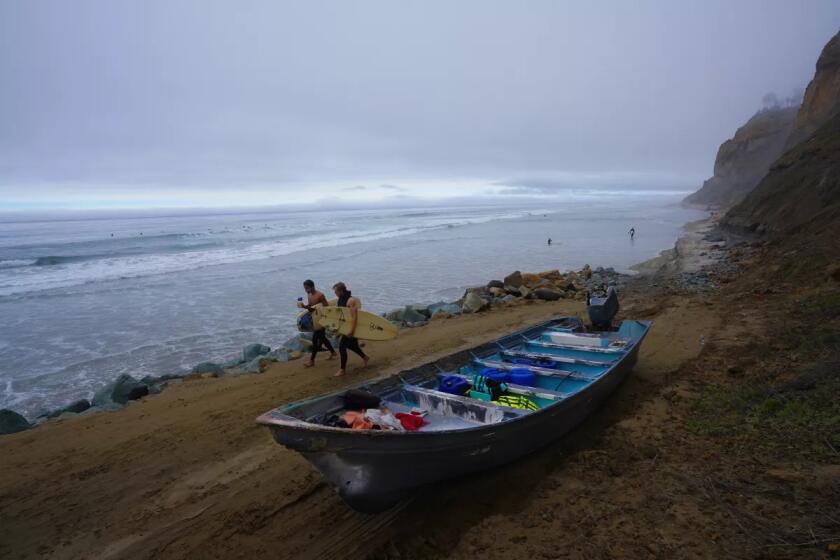Michael Smolens: Move by two small water districts could have impact across Southern California

By joining Riverside district, Fallbrook and Rainbow could save on water, but cost other San Diego ratepayers
The Fallbrook and Rainbow water districts got the green light to, in effect, move north.
That will impact ratepayers in San Diego County, and it could alter the balance of power in water decisions far beyond.
Like so many contentious developments when it comes to water, this one might not be over for a while.
Since 2019, the Rainbow Municipal Water District and Fallbrook Public Utility District have been working to join Riverside County’s Eastern Metropolitan Water District, which promises cheaper water. The two agricultural districts in North County have been chafing at the increasing costs of water from the San Diego County Water Authority.
On Monday, they received approval to pull out of the SDCWA from the Local Agency Formation Commission, a government agency that oversees such jurisdictional matters.
The county water authority opposed the move, saying it will raise rates to varying degrees for residents served by the regional agency’s 22 other members. That is not in dispute, though there’s disagreement about how much the exit will cost ratepayers.
SDCWA officials appear to be as concerned, perhaps even more so, about what this change would mean to long-term relations with the powerful Metropolitan Water District of Southern California based in Los Angeles — and how it might affect San Diego residents.
The county water authority is a member of Metropolitan, as is the Eastern district. The shift by Fallbrook and Rainbow would weaken the San Diego authority’s voting power on the MWD board while strengthening Eastern’s.
There’s a history of dispute, particularly between San Diego and Metropolitan. Eastern actively worked to block San Diego from receiving refunds from MWD for what the county water authority maintained were illegal rates, according to a water authority letter to LAFCO. Metropolitan said its prices were justified.
That, among other issues, resulted in decades of litigation, and more than a few hard feelings.
Under the move by Fallbrook and Rainbow, San Diego would lose a slight percentage of its current voting rights at MWD, while Eastern would gain slightly. It’s not much of a difference, but it potentially could be enough to shift the MWD board direction in some situations that were beneficial to San Diego.
(The above paragraph has been clarified regarding voting rights.)
By the narrowest of margins, the board in 2021 hired Adel Hagekhalil as general manager and chief executive officer and in January of this year installed Adán Ortega Jr. as chair.
Those two won out over people the county water authority view as more hostile. San Diego and MWD are still in litigation, but there have been increased efforts to collaborate and build consensus since Hagekhalil came on board and Ortega rose in power. A change in San Diego leadership and a new attitude toward MWD also contributed to an improved atmosphere.
This isn’t to say the change in voting power — which is determined by the assessed property value within each district — would necessarily result in the ouster of Hagekhalil and Ortega. But, like the San Diego authority, MWD has its divisions.
Ortega, in particular, has been outspoken in opposition to Rainbow and Fallbrook leaving SDCWA. He has further said that the move by the two districts must be approved by the MWD board. Rainbow and Fallbrook disagree, as did previous MWD leaders.
“Voting power makes a difference,” said Jim Madaffer, vice chair of both the county water authority board and the Colorado River Board of California, which represents the state in negotiations over management of the river that serves 40 million people. “This is an important issue for ratepayers in San Diego.”
MWD’s control over water availability and what it charged motivated San Diego leaders to seek diverse sources of water. They did so by embarking on a program two decades ago to increase reservoir storage, build pipelines, construct a desalination plant in Carlsbad and, importantly, gain Colorado River water from the Imperial Irrigation District largely through conservation measures.
All that left San Diego not only far less reliant on MWD, but with a plentiful water supply. It came at a steep cost, however, and triggered the decisions by Rainbow and Fallbrook to exit.
Further, SDCWA underestimated the impact of water conservation efforts and is in a precarious financial situation because its water sales have plummeted. Now the region is overstocked and is looking to sell water elsewhere. Some LAFCO members pushed for an examination of how the water authority operates.
The process of the Fallbrook and Rainbow “divorce,” as it is often called, was filled with suspicion and maneuvering.
Officials opposed to the split maintained the exit fee estimated by LAFCO staff was low and based on outdated data. Leaders of the two districts and LAFCO officials suggested the county authority overstated the potential economic hit.
That the meeting was held Monday also raised questions. Initially, it was scheduled for August. But last month the session was moved up to this week. It was widely known that LAFCO board member Jo McKenzie, president of the Vista Irrigation District, who opposed the exit, would not be available.
McKenzie was replaced by alternative commissioner David Drake, president of the Rincon del Diablo Municipal Water District and a supporter of the move. Fallbrook and Rainbow prevailed on a 5-3 vote. A tie vote would have defeated the proposal.
Voters within the Fallbrook and Rainbow districts will have to approve of the exit for it to happen. The county water authority is virtually certain to file a lawsuit, contending the plans must be subject to environmental review, among other things. The districts say what they’re doing is exempt from such reviews.
Opponents of the districts leaving say a countywide vote should be held because people across the region will be affected. That’s not part of the current process, though a challenge is under way.
A bill by Assemblymember Tasha Boerner, D-Encinitas, is moving through the Legislature to require a countywide vote. If SDCWA obtains an injunction, that likely would give time for the legislation to become law.
When it comes to water disputes, litigation and political intrigue is the California way.
Get Essential San Diego, weekday mornings
Get top headlines from the Union-Tribune in your inbox weekday mornings, including top news, local, sports, business, entertainment and opinion.
You may occasionally receive promotional content from the San Diego Union-Tribune.











